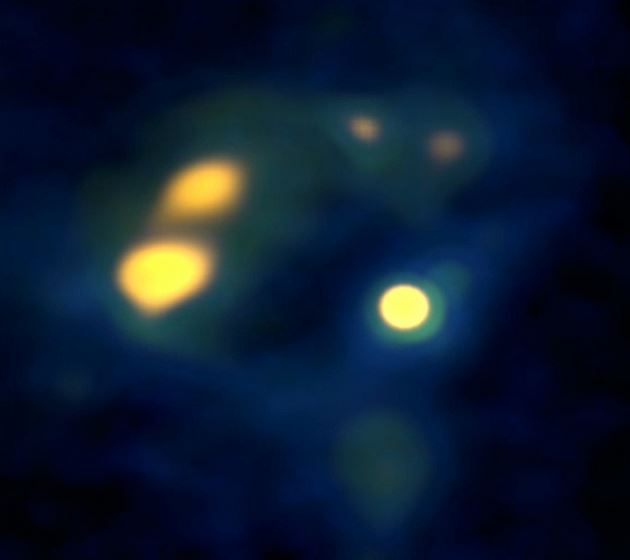A cosmic dinosaur is about to hatch, say scientists, who have discovered what may be the first known example of a globular cluster on verge of being born – an unimaginably massive, extremely dense, but star-free cloud of molecular gas.
A globular cluster is a huge compact spherical star cluster, typically of old stars, a dazzling agglomeration of up to one million ancient stars, in the outer regions of a galaxy.
Globular clusters are among the Universe’s oldest objects. Although abundant in and around several galaxies, about-to-be-born examples are vanishingly rare, and the conditions required to create new ones have never been detected …. until now, that is.

ALMA image of dense cores of molecular gas in the Antennae galaxies. The round yellow object close to the center could be the first prenatal example of a globular cluster ever identified. It is surrounded by a giant molecular cloud. (Image: public.nrao.edu)
The globular cluster on the verge of being born was discovered by Kelsey Johnson, an astronomer at the University of Virginia in Charlottesville, and colleagues using the Atacama Large Millimeter/submillimeter Array (ALMA) in northern Chile.
The scientists published their findings in the Astrophysical Journal.
Lead author, Prof. Johnson said:
“We may be witnessing one of the most ancient and extreme modes of star formation in the universe. This remarkable object looks like it was plucked straight out of the very early universe.”
“To discover something that has all the characteristics of a globular cluster, yet has not begun making stars, is like finding a dinosaur egg that’s about to hatch.”
The ‘Firecracker’
This celestial object, which the scientists humorously refer to as the ‘Firecracker’, is located about fifty million light-years away from Earth, nestled within a famous pair of interacting galaxies – NGC 4038 and NGC 4039 – collectively known as the Antennae galaxies.
Their ongoing merger generates tidal forces that trigger star formation on a colossal scale, with much of it taking place within dense clusters.
What makes Firecrakcker unique, however, is its incredible mass, relatively small size, and apparent lack of stars.
All other similar globular clusters scientists have so far observed are already teeming with stars. The radiation and heat from these stars have therefore changed the surrounding environment significantly, erasing any trace of its colder, quieter beginnings.
With ALMA, the scientists were able to find and examine in detail a perfect example of such an object before stars forever change its unique features.

(Upper image) The Antennae galaxies. (Centre right image) Extensive clouds of molecular gas. (Bottom image) One cloud is incredibly massive and dense, yet apparently star free. (Image: public.nrao.edu)
This gave the astronomers a first-ever peek into the conditions that could have led to the formation of several, if not all globular clusters.
Prof. Johnson said:
“Until now, clouds with this potential have only been seen as teenagers, after star formation had begun. That meant that the nursery had already been disturbed. To understand how a globular cluster forms, you need to see its true beginnings.”
The majority of globular clusters were formed during a veritable cosmic ‘baby boom’ about 12 billion years ago, at a time when galaxies started assembling.
Each cluster contains up to one million densely packed ‘2nd generation’ stars: stars with noticeably low concentrations of heavy metals, suggesting they formed soon after the birth of our Universe.
We know of 150 such clusters in our own galaxy, the Milky Way – there could be many more.
Across the entire Universe, star clusters of various sizes are still forming today. It is possible, the authors say, though increasingly rare, that the largest and densest of these will go on to become globular clusters.
Prof. Johnson said:
“The survival rate for a massive young star cluster to remain intact is very low – around one percent. Various external and internal forces pull these objects apart, either forming open clusters like the Pleiades or completely disintegrating to become part of a galaxy’s halo.”
The scientists believe, however, that the celestial object they detected with ALMA, which contains fifty million times our Sun’s mass in molecular gas, is sufficiently dense that it has a good chance of being one of the lucky ones.
Globular clusters soon evolve out of their embryonic star-free stage – this can occur in as little as 1 million years. This means that what the astronomers observed with ALMA is undergoing a key milestone of its life, offering them a unique opportunity to study a major component of a very young Universe.
According to the ALMA data, the Firecracker cloud is under immense pressure – about 10,000 times greater than typical interstellar pressures. This supports previous theories that for globular clusters to form, extremely high pressures are required.
In exploring the Antennae, the team observed the faint emission from carbon monoxide molecules, which allowed them to image and characterize individual clouds of gas and dust.
The lack of any discernible thermal emission – a hallmark signal given off by gas heated by nearby stars – confirmed that this newly-discovered celestial object is still in its unaltered, pristine state.
Subsequent ALMA studies may reveal more examples of proto super star clusters in the Antennae galaxies and other interacting galaxies, which may provide insight into the origins of these ancient objects and the role they play in the evolution of galaxies.
Citation: “The Physical Conditions in a Pre Super Star Cluster Molecular Cloud in the Antennae Galaxies,” K. E. Johnson, A. K. Leroy, R. Indebetouw, C. L. Brogan, B. C. Whitmore, J. Hibbard, K. Sheth, A. Evans. Arxiv. arXiv:1503.06477 [astro-ph.GA].
Video – Proto Super Star Cluster
